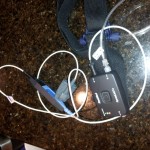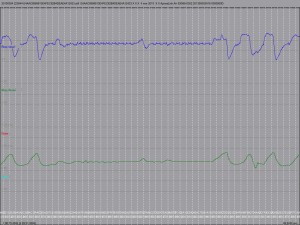At a follow-up trip to my neurologist I mentioned catching myself not breathing occasionally at night, at which point he ordered up a sleep study. Unlike the previous sleep studies I’d done several years ago, this was a home sleep study. FedEx delivered a sleep study kit to my door Wednesday with instructions on how to use it.
We went to the kids’ wonderful Pieces of Gold presentation and got home late. I was in little mood to dig through the paperwork and assemble this thing, and yet I was also tired of being tired all the time. I fumbled through setting up this ResMed ApneaLink Air device that was about the size of a pack of cigarettes and had tiny hoses and wires poking out of it. Surprisingly, it was more comfortable than I thought and soon I was snoozing away.
My directions said to wear it two consecutive nights, so after the second night (last night), I prepared the kit for shipping back. As I wrapped the cables up, I noticed the USB port on the box.
Hmm, I thought. I bet this acts as a USB drive if I plug it into my laptop.
Sure enough, I was right! Being a geek whose day job is all about monitoring stuff, I couldn’t let the opportunity to study my breathing signals pass me by. I copied the half-dozen files from the kit to my hard drive and sealed up the kit for shipping back.
Looking at the files this evening, I saw they were in EDF format, which good ol’ Wikipedia tells me is European Data Format – a standardized way of representing data from medical devices. This gave me high odds of finding something with which to read the data, and a few more clicks told me about an open-source tool for Linux called EDFBrowser. There is even an Ubuntu package already built, so a quick “sudo apt-get edfbrowser” gave me all I needed to view my data.
To my untrained eye the results looked unremarkable. Data points like “Resp nasal,” “Resp thorax,” “pulse,” and “SaO2” trailed from one side of the screen to the other. Neatly-spaced wavy lines outlined every single breath I took through the night. Viewed from end to end, the waves showed an uneventful night.
But that wasn’t the full story. Becoming more adept at using EDFbrowser, I zoomed in and the picture changed. It seems the lines weren’t as even as I thought. Scrolling the cursor, my eyes widened at a gap of 30 seconds where I wasn’t breathing.
It was the smoking gun. Apnea.
Fortunately there aren’t many gaps like that in the data but that probably matters little. I suppose that one can sleep well for 99.9% of the evening and the .1% of not breathing is all it takes to derail a good night’s sleep.
I won’t be surprised if my doctor diagnoses apnea and talks about options. I have never been too fired up about wearing a CPAP but getting good sleep is worth the hassle, I think.
We’ll see what the doc says.

